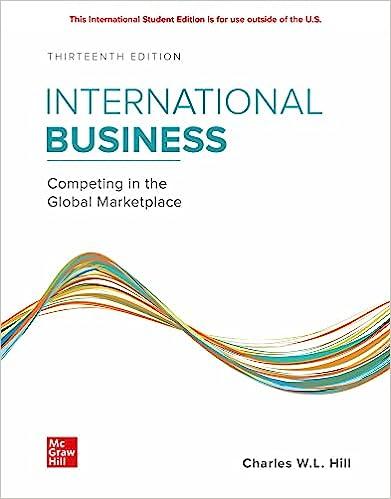Between 2015 and early 2018, the Chinese currency, the yuan, fluctuated significantly in value against the U.S.
Question:
Between 2015 and early 2018, the Chinese currency, the yuan, fluctuated significantly in value against the U.S. dollar, giving Chinese businesses an object lesson in the importance of managing for foreign exchange risk.
From August 2015 through to December 2016, the value of the yuan in dollars depreciated by 12 percent from 6.2 to the dollar to 6.95 to the dollar. This depreciation was triggered by a slowdown in the Chinese economy, which led to an outflow of capital from China. Even though the Chinese government spent heavily to try to prop up the value of the yuan, using $1.5 trillion of dollar-denominated foreign exchange reserves to purchase yuan, they could not halt the decline in its value against the dollar.
While the depreciation in the yuan boosted exports, it also resulted in an unanticipated increase in the yuan price of key imports, which raised costs for a number of Chinese companies. About 980 listed Chinese companies reported combined foreign-exchange losses of 48.7 billion yuan in 2015, almost 13 times higher than 2014, according to data compiled by Bloomberg. Hardest hit were Chinese airlines, many of which imported aviation fuel that was paid for in dollars. As the cost of fuel in terms of yuan went up, their profits slumped. In total, the Chinese airline sector registered foreign exchange losses of 17.9 billion yuan for 2015, compared with 951.7 million a year earlier. The big three stateowned airlines—China Southern Airlines Co, China Eastern Airlines Corp, and Air China Ltd—suffered 15.85 billion yu an in forei gn -excha nge cur re ncy l osse s in 2015.
In 2017, conditions reversed. Between January 2017 and April 2018, the yuan appreciated in value by 10 percent against the dollar, increasing from 6.95 to the dollar to 6.27 to the dollar. The appreciation was due to a number of factors, including a return to stronger growth in China and the election of Donald Trump in the United States. The latter event seems initially to have reduced the confidence that foreign investors had in the United States and resulted in an outflow of capital as they sought to diversify their holdings of foreign assets and currency. The dollar also fell after members of the Trump administration made statements suggesting that they were happy to see it decline, because they believed it boosted U.S. exports.
The appreciation in the value of the yuan against the dollar from January 2017 onward reduced the yuan costs for Chinese companies that imported goods priced in dollars, such as aviation fuel. Thus, Air China noted in its 2017 annual report that a 1 percent gain in the yuan against the greenback can boost its net profits by about 280 million yuan, primarily due to reductions in the cost of aviation fuel.
On the other hand, the appreciation of the yuan raised the dollar price of Chinese exports. Many exporters saw their profits squeezed as a result. In early February 2018, Guangdong Goworld, a supplier to Apple, said in a stock exchange filing that it had suffered an estimated foreign exchange loss of 45 million yuan (US$7.2 million) in January 2018 owing to a stronger yuan. The January figure alone was equal to 94 percent of its foreign exchange losses for the first three quarters of 2017. It also translated into 34 percent of its net profits in the first nine months of 2017. The Shenzhen-listed company manufactures and sells printed circuit boards, liquid crystal displays (LCDs), and ultrasonic electronic measuring instruments to developed markets, including the U.S., Europe, Australia, and Japan.
In another example, a spokesperson for Zhejiang NHU Co., a producer of vitamins, said that even as the vitamin export market experienced a boom in 2017, the company suffered millions of yuan in foreign exchange losses. The basic problem was that the company negotiated dollar prices for its vitamins in 2016, but by the end of 2017, each dollar of sales was yielding less revenues when translated back into yuan (thanks to the appreciation of the yuan). To deal with this problem, the company set up a team to discuss the issue and employed means such as hedging and forward exchange transactions to try to minimize foreign exchange risks.
Questions
1. Why did the Chinese yuan depreciate against the dollar between August 2015 and December 2016? What were the benefits of the depreciation for China? What were the costs?
2. Why do you think the Chinese government tried to limit the depreciation by using dollars to buy yuan? Why did it not stop the fall in the yuan?
3. Why did conditions reverse in 2017, with the yuan appreciating against the dollar? What does this tell you about how the foreign exchange market works?
4. What could importers such as the Chinese airlines have done to limit the negative impact of a depreciation in the value of the yuan against the dollar in 2016? Should they have done this?
5. If you were a Chinese exporter, what might you have done if you had anticipated the appreciation in the value of the yuan against the dollar that occurred in 2017?
Step by Step Answer:

ISE International Business Competing In The Global Marketplace
ISBN: 9781260575866
13th International Edition
Authors: Charles Hill





